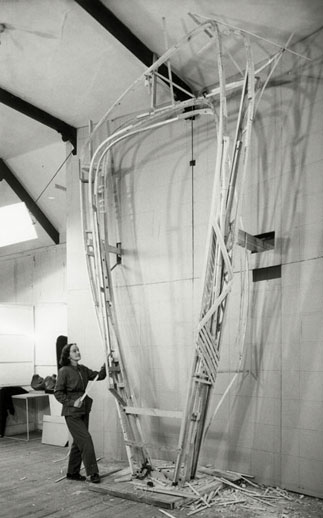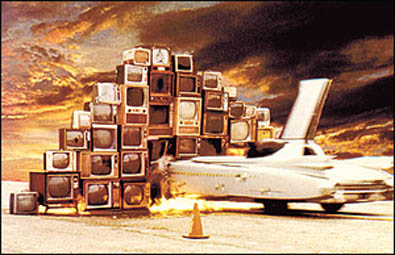|
|
|
| home | features | exhibitions | interviews | profiles | webprojects | gazetteer | links | archive | forum | |
|
The art of collaborating: from Michelangelo to Warhol and beyond With the NSA collaborations show 'Double Vision' scheduled to open in October '09 at the Exchange in Penzance, Rupert White reflects on aspects of the art of collaborating...
Some cultural products lend themselves to similar processes of mass-production, and, fittingly, are referred to as 'industries'. Films, like TV programmes, are usually constructed by large teams working together. Computer games and other types of computer software are also developed by teams. Typically in these cases there is a division of labour with artists and programmers working alongside each other. In the West the all-important discourse regarding the meaning and value of art and artworks is produced collaboratively, though it is far from being a democratic process. It is also part of a complex 'communal' chain of production. However visual art is, in other respects, more akin to poetry or novel-writing in being a minority cultural 'product' that is valued for its uniqueness, its individuality, and its link to one person's subjective viewpoint. In the Renaissance, and at other times prior and subsequent to this, teams of artists have worked to execute designs too large or complex for one artist to complete alone. The Sistine Chapel in the Vatican is the most famous example. This practice, which was fairly widespread for more than a century, declined in the modern Humanistic or Romantic era. In the 20th century the idea that someone like Van Gogh, Munch or Pollock might have got someone else to help them execute their paintings would have been unthinkable. For a while, and for Romantic or Expressionist artists, the link between the individual artist and the unique art-product became inseparable. This was true for most artists of the period, including many in St Ives in Cornwall, UK. However there were exceptions. For example we know that Barbara Hepworth had assistants helping her to make her larger more substantial sculptures. (Yet, tellingly, as Terry Frost has recounted they were expected to make themselves scarce if critics or collectors were visiting the studio, and they were never allowed to appear in photographs (picture above right)).
In fact Warhol, having come from a commercial art background - and as someone who also made many films during his lifetime - possibly did more than any other artist in the 20th Century to explore notions of collaboration and to unpick the established Expressionist paradigm of the previous generation. Many forget that, as well as mass producing screen-prints, Warhol was involved in producing trashy Hollywood-style films like 'Heat', 'Flesh for Frankenstein', 'Lonesome Cowboys' and 'My Hustler', and producing the magazine 'Interview'. Warhol's attitude and model of working, both linked as they were to his suspicion of the notion of 'self-expression' has been a big influence since. Other collaborative modes of working emerged in the 60s and 70s. 'Ant-farm' were typical of a new breed of artist-group to emerge in this period, as were, in the UK, COUM Transmissions (later Throbbing Gristle) and the Boyle family. Increasingly pairings of artists were also seen, like the Bechers, and Gilbert and George. Interest in working across disciplines increased and in London John Latham is remembered, amongst other things, for having helped set up the Artist Placement Group (AGP), an organisation that was active for around 20 years and sought to place artists within unlikely corporate or industrial settings.
In Cornwall artists have tended to come together as transient artist-groups or pairings for individual projects: eg PALP, Art Surgery, GREENCUBE, AACCEHHJKLLNORRS and Blackborow, Donnelly and Paige, but there are currently few true regular collaborators, with the exception of Carter and Zierle, F I E L D C L U B and predominantly theatrical or musical groups such as Wild Works, Kneehigh (David Kemp the sculptor has worked with both), Nocturnal Emissions and Hedluv. Some of the former are involved with intensive public engagement, as was, for example, the BOSarts project in Bosigran last year. There has also been a degree of contact with the health community: Robin Hawes of iRes has worked collaboratively with opthalmologists, Sue Bleakley with the medical school, and Arts for Health have placed art and artists in health settings.
Its important to note that these different collaborative models suggest different levels of 'authorship'; and also that some are less benign, or more honorable, than others. Warhol's factory model, as developed subsequently by eg Damien Hirst is of course, not an equal collaboration. Whilst the works are made by a process of 'co-labouring', the assistants are not acknowledged as the authors or originators of the idea, and the balance of power in the process of collaborating is not equal*. Is this a problem? Not in itself, but the Hirst factory model seems intended to callously maximise the artist's profits in mass-producing Hirst-brand luxury goods. In so doing it discredits the art-world, undermines the position of more well-intentioned artists, and is a bit demeaning for all involved. More equitable and socially-committed 'co-labouring' with other disciplines and non-human collaborators, would, in contrast, seem to offer the potential for art to move away from such a narrow commercial and ultimately self-destructive path.
*Interestingly it wasn't all one-sided in Warhol's case: he was co-credited with Paul Morrissey for many of the films, and later in his career he shared the credit or authorship for paintings made with the ill-fated darling of the 80s New York art scene: Jean Michel Basquiat. |
|
|
|

 Human
societies are characterised by a tension between
competition and collaboration with others. In industrial societies this
is epitomised by market competition and the production of consumer
goods. Here design, science and technology are linked together, with
large numbers of people organised into chains of production in order to
produce goods cheaply and efficiently.
Human
societies are characterised by a tension between
competition and collaboration with others. In industrial societies this
is epitomised by market competition and the production of consumer
goods. Here design, science and technology are linked together, with
large numbers of people organised into chains of production in order to
produce goods cheaply and efficiently.  In
contrast, in the 60s, a more overtly mechanistic type of art-manufacturing process was celebrated by Andy Warhol who,
appropriately called his studio 'The Factory'.
In
contrast, in the 60s, a more overtly mechanistic type of art-manufacturing process was celebrated by Andy Warhol who,
appropriately called his studio 'The Factory'.  In
recent years the factory and the
artist-placement model of
collaborating have continued to be important. Big-name artists like
Damien Hirst in the UK have been able to afford to pay assistants to
help them make work, whilst more socially engaged artists have explored
working alongside scientists or doctors. A recent example of the latter
would be David Cotterrell's Wellcome Trust placement in Hellmand
Province, Afganistan. Artist-groups and pairings continue to be a
feature, albeit minor, of the contemporary scene: think Chapman
Brothers, Juneau Projects (see interviews), Fischli and Weiss, Thomson and Craighead
(see webprojects) and SUPERFLEX
(see Burning Car below).
In
recent years the factory and the
artist-placement model of
collaborating have continued to be important. Big-name artists like
Damien Hirst in the UK have been able to afford to pay assistants to
help them make work, whilst more socially engaged artists have explored
working alongside scientists or doctors. A recent example of the latter
would be David Cotterrell's Wellcome Trust placement in Hellmand
Province, Afganistan. Artist-groups and pairings continue to be a
feature, albeit minor, of the contemporary scene: think Chapman
Brothers, Juneau Projects (see interviews), Fischli and Weiss, Thomson and Craighead
(see webprojects) and SUPERFLEX
(see Burning Car below).